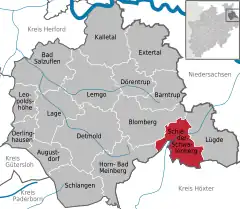Schieder-Schwalenberg
Schieder-Schwalenberg (Low German: Schüer-Schwalenberg)[3][4] is a town in the Lippe district, in North Rhine-Westphalia, Germany. It is situated approximately 20 km (12 mi) east of Detmold.
Schieder-Schwalenberg | |
|---|---|
-Pano.jpg.webp) | |
 Coat of arms | |
Location of Schieder-Schwalenberg within Lippe district  | |
 Schieder-Schwalenberg  Schieder-Schwalenberg | |
| Coordinates: 51°53′N 09°11′E | |
| Country | Germany |
| State | North Rhine-Westphalia |
| Admin. region | Detmold |
| District | Lippe |
| Subdivisions | 9 |
| Government | |
| • Mayor (2020–25) | Jörg Bierwirth[1] (Ind.) |
| Area | |
| • Total | 60.04 km2 (23.18 sq mi) |
| Elevation | 213 m (699 ft) |
| Population (2021-12-31)[2] | |
| • Total | 8,308 |
| • Density | 140/km2 (360/sq mi) |
| Time zone | UTC+01:00 (CET) |
| • Summer (DST) | UTC+02:00 (CEST) |
| Postal codes | 32816 |
| Dialling codes | 05282, 05284, 05233 |
| Vehicle registration | LIP |
| Website | www |
It consists of 8 communes, which have been combined to a town in 1970. The names of the communes are Schieder, Brakelsiek, Schwalenberg, Lothe, Ruensiek, Wöbbel, Siekholz and Kreienberg, the district Schieder together with Glashütte is a Kneipp health resort. Together they have c. 8,400 residents (2020).
Geography
Schieder-Schwalenberg is located between the Teutoburger Wald and the Weserbergland. The district of Schieder is situated on the banks of Schiedersee, an artificial lake that is fed and drained by the River Emmer.
Coat of arms
The swallow on the red ground depicts Schwalenberg's municipal coat of arms. On the blue ground the crown represents the summer residence of the House of Lippe, the castle at Schieder. The white line in between represents the River Emmer.
Economy
The main industrial sector is the furniture industry. Schieder Möbel are the main producer of furniture. Apart from the furniture branch tourism plays an important part in the economy. Tourists, mainly from Germany, Denmark and the Netherlands, often come to rent holiday flats for a short break. The Schiedersee and the Glashütte district attract many visitors.
History
.jpg.webp)
The County of Schwalenberg was first mentioned with count Widekind I in 1127. The original seat of the counts had been Oldenburg Castle at Marienmünster. The monastery of Marienmünster was founded by the counts in 1128. Schwalenberg Castle was built between 1228 and 1231 by count Volkwin III. During the 13th century the territory of the counts was split between several branches, creating the county of Schwalenberg itself (then mainly restricted to a small territory around Schwalenberg Castle), the county of Pyrmont (existing from 1194 until 1495), the county of Waldeck (existing as a principality until 1918) and the county of Sternberg (existing from 1243 until 1377, later disputed between the counts of Schaumburg and the counts of Lippe). When the Schwalenberg branch extinguished in 1365, its territory was divided between the House of Lippe (which used Schwalenberg Castle as a seat of junior branches and later distributed parts of the county to its branches Lippe-Biesterfeld and Lippe-Weissenfeld), and the Prince-Bishopric of Paderborn.
References

- Wahlergebnisse in NRW Kommunalwahlen 2020, Land Nordrhein-Westfalen, accessed 21 June 2021.
- "Bevölkerung der Gemeinden Nordrhein-Westfalens am 31. Dezember 2021" (in German). Landesbetrieb Information und Technik NRW. Retrieved 20 June 2022.
- "Nachweis:Plattdeutscher Ortsname Schieder" (PDF). (PDF)
- "Nachweis: Plattdeutscher Ortsname Schwalenberg".
External links
- Official Website of Schieder-Schwalenberg (in German)
- Schiedersee (in German)
- Website of the TuS 08 Brakelsiek Football Club in Schieder-Schwalenberg (in German)